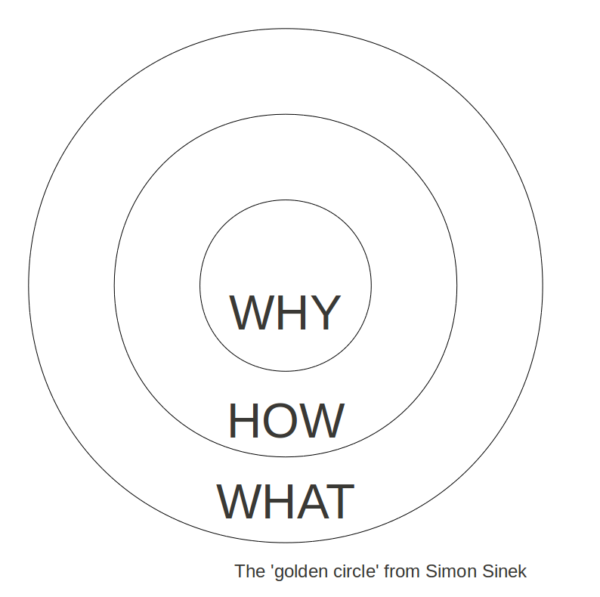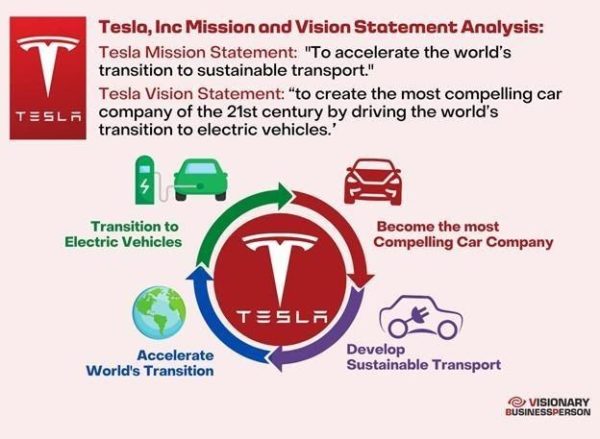Few businesses today can thrive by simply inundating customers with messages about the features and benefits of their products or services. People need a deeper reason to choose your brand over another. If you’re not sure what that reason is, your business will likely struggle to thrive among all the competition.

The sheer volume of companies seeking to gain and keep a foothold in today’s market means that your business needs something special to get through all the noise, and this is where the Golden Circle theory comes into play.
Originally coined by Simon Sinek, leadership expert and author of the classic “Start With Why,” the Golden Circle theory argues that many of today’s most successful companies think beyond the practical, rational benefits of the products and services they offer. While some companies start by explaining what they offer to their customers, big names like Apple begin by examining the how and the why behind their business first.
Just consider Apple’s slogan “Think Different” and how unrecognizable this tech behemoth would be today if it instead settled on “We sell computers.” From Apple’s perspective, customers choose a business based on more nebulous, emotional reasons than simply needing a MacBook or iPhone. In short, people want to support companies driven by shared values and beliefs.
Apple was able to thrive by appealing to customers in a more meaningful way from the start. But why does this tie in with the Golden Circle, and how can companies incorporate it into their own marketing plans? Read on to discover the basics of the Golden Circle theory, how it applies to marketing, and what makes it so important for businesses large and small.
What is the Golden Circle theory?
While it may seem like the reasons people choose one company over another are difficult to pin down, the Golden Circle theory suggests otherwise. From a customer’s perspective, it can appear that businesses simply want to make money and that values or the “why” are afterthoughts.
However, companies like Apple approach things in a completely different way by starting with their “why” before mentioning their products, and the “how” and “what.” The fundamentals of the Golden Circle theory are relatively straightforward and consist of three main parts.

The “why”
Since, as Sinek says, “People don’t buy what you do, they buy why you do it,” the question of “why are we in this business?” should be the focal point of any brand. Naturally, small business and nonprofit leaders are focused on the bottom line, but there is a valuable story to be told via the reasons why your business or nonprofit does what it does.
Perhaps there’s an unfulfilled need in the marketplace or your community that your business will cover, or maybe you simply have an innovative vision for the future of your industry. Perhaps your business has a personal, or mission-driven “why.”
The “why” behind your brand should define the overarching purpose of the company beyond the bottom line, giving customers and employees a more meaningful reason to support your business.
A great example of an established brand explaining its “why” can be seen in Tesla’s mission statement: “Tesla believes the faster the world stops relying on fossil fuels and moves towards a zero-emission future, the better.” This simple sentence summarizes the foundation of Elon Musk’s company, attaching his brand to a nobler endeavor than simply selling electric vehicles or solar panels.
The “how”
The next part of the Golden Circle theory addresses how your brand achieves its “why” objective. This may include the processes or systems that separate your business from competitors. For example, you can create an online clothing store that uses only ethically sourced fabrics to support your “why” of moving fashion in a more sustainable direction.
For Amazon, Jeff Bezos’s stated “why” goal is to “continually raise the bar of the customer experience by using the internet and technology to help consumers find, discover and buy anything.”
How did his company manage to meet this objective and become such a powerhouse in the ecommerce industry? For one thing, Amazon built a robust platform that’s easy to use, bringing thousands of merchants together into a single online marketplace. To ensure expedited deliveries at a lower cost to subscribers, Amazon also created its own fleet of vehicles and established micro-fulfillment centers across the United States.
The “what”
The final aspect of a Golden Circle brand is what your company actually does in terms of the products or services it provides. This portion of the Golden Circle theory should position your company in the market as a distinctly unique and innovative industry leader.
While this part of the Golden Circle seems self-explanatory, it’s important to consider how your offerings correspond to the why and how that defines your brand. What is it about your products or services that bolster the purpose of your company? For a company like Tesla, selling electric vehicles is simply a means to achieve its stated goal of making the world less dependent on fossil fuels.
Regardless of “what” you are selling, your products or services must relate to the company’s primary vision and motivation. If you keep the “why” squarely in mind, compelling brand messaging will follow.
Examples of the Golden Circle in action
Considering the value of the Golden Circle in establishing a trusted and easily recognizable brand, it’s no wonder that some of today’s most successful companies follow this model. To illustrate how this theory works in practice, it may help to examine what major industry contenders are doing. Here are some Golden Circle theory examples seen in the real world today.

Amazon
Since its inception in 1994, Amazon has remained true to its original vision of providing the best possible experience to all its customers. This customer-centric attitude serves as the central focal point of its Golden Circle brand.
But how does the company achieve this? As mentioned above, they built a platform that helps customers find, discover and buy anything, which today means everything from grocery items to movies for streaming. For a company like Amazon that sells virtually anything under the sun, the “what” of its brand is far less defined compared to its “why” and “how.”
With that said, all its products do share one common thread: You can buy anything at the click of a button, shipped directly to your door. This effortless convenience and seemingly endless range of products that Amazon offers are difficult for other companies to replicate. Staying committed to its core values and motivation is a big reason why Amazon has managed to grow from under 200,000 active users in 1996 to the single largest company in the world.
Home Depot
This Golden Circle brand is another excellent example of a company finding its purpose through serving its customers. The original Home Depot stores carried the tagline “Atlanta’s Do It Yourself Warehouse,” and the company has certainly grown far past Atlanta in the four decades since its founding.
In a book detailing the humble beginnings of Home Depot, co-founder Bernie Marcus writes, “At the end of the day, we’re in the people business.” This commitment to customers answers the “why” that continues to drive the company forward. Its “how” involves training store employees in construction skills to be as helpful as possible, while providing tools and materials to fit every building need.
Home Depot’s spirit of doing the right thing also contributes to actively improving the communities it inhabits through the Home Depot Foundation. This foundation helps improve housing for veterans, provides funding for communities recovering from natural disasters, and supports the training of tradespeople through its Path to Pro program.
By putting people first, Home Depot established itself as one of America’s most trusted home improvement supply stores.

Tesla
Tesla’s “why” is simple: Completely reimagine transportation and energy. How does it aim to fulfill this objective? It seeks out and supports creative solutions to facilitate the transition to sustainable energy alternatives as quickly as possible.
Naturally, the “what” in Tesla’s Golden Circle consists of innovative products like the Powerwall, the Solar Roof, and its line of appealing electric vehicles. Tesla’s penchant for innovating for the future — often at the cost of short-term profit — gives this company a more commendable status among its competitors, spurring continued growth and success.
Spotify
This streaming service is a great example of a company built upon the ideas of the Golden Circle theory. Spotify’s mission is to “unlock the potential of human creativity,” and it does this “by giving a million creative artists the opportunity to live off their art and billions of fans the opportunity to enjoy and be inspired by it.”
Today, Spotify offers more than 70 million songs and podcasts to make its vision a reality and is one of the biggest streaming companies in the world. Like the other companies on this list, Spotify recognizes that what it offers is secondary to why it does it, and it shows.
Best of all, Spotify users can feel good about using the streaming service since listening to a song directly contributes to supporting the artist who created it. This win-win situation is a big part of the reason why Spotify has managed to become so successful.
The benefits of using the Golden Circle model
The truth is that many companies that don’t understand their core values and motivation will simply focus on selling products to turn a profit. No matter what kind of business you have, the Golden Circle model is an invaluable tool to use when forging a greater vision for your company’s future and communicating with your customers on an emotional level.. Here are the key advantages to using the Golden Circle theory to build a distinct brand for your business.
Keeps brand messaging consistent
Understanding your company’s why, how, and what can serve as the North Star that guides your company forward. The values and motivations your business upholds will inhabit every aspect of how your company operates, from customer service to the workplace culture.
This means that all of your correspondence, advertising, and press releases will take on a consistent, easily recognizable tone that’s unique to your brand. The Golden Circle can help to guide customer engagement strategies as well by honing the focus of content marketing, email, and social media posts.
Provides clear direction
The Golden Circle model helps to frame the course of your company’s future by establishing ground rules and intrinsic purpose from the start. By pursuing your goals with persistence, your company will always have a clear path forward to navigate today’s highly competitive marketplace.
As other businesses struggle for brand recognition or higher profits, you will already know exactly what your company stands for, what it hopes to accomplish, and how it intends to get there.
Helps your company stand out
People know how to tell the difference between a business that cares and one that simply focuses on the bottom line. Companies that follow the Golden Circle theory are more likely to stand out from the crowd and attract a loyal following of customers who support the same goals. Given time, your company will begin to build brand awareness that’s completely different from any competitors, ensuring your message never gets lost in the noise.
Reflect on the “why,” “how,” and “what” for your business
Think back to the earliest days of your business. What motivated you to go down this particular path? Which of your personal values, interests and beliefs led you to this business? Do you own a natural foods store because you care about supporting the health of your community? Perhaps you own a custom sneaker business because you value fashion and want to inspire creativity.
Will your stock price someday match that of Tesla or Apple? Maybe, maybe not, but your brand messaging could certainly be on par if you consistently stick to your “why,” “how,” and “what” in everything you say and do. Centering all of your marketing activities on your company’s Golden Circle could help you speak to your customers in a much more meaningful and memorable way.
The beauty of this theory is in its simplicity. It’s something that can be applied by any business owner. Your first step? Grab a piece of paper and a pen, draw the Golden Circle diagram and label it with your “why,” “how,” and “what.” Talk about it with your employees, post it on a wall where it will be seen every day, and join the Apples, Teslas and other branding heavy hitters in creating a strong and valued brand.




